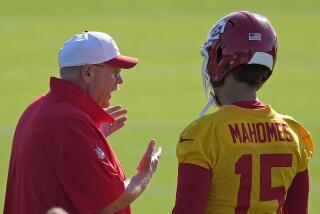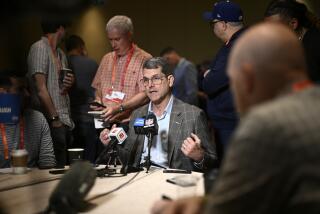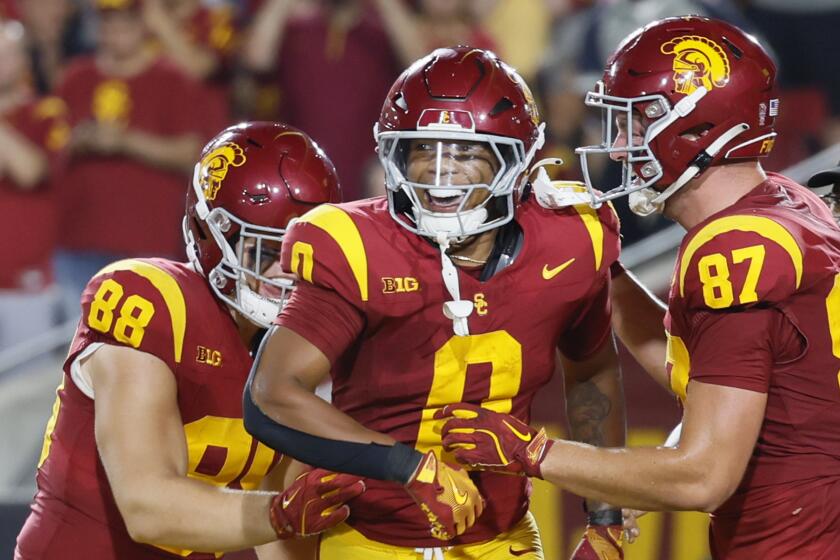Column: ‘Help Wanted’ is sign of the times in NFL
At least a quarter of the NFL’s 32 teams are changing head coaches, and that should startle no one.
Black Monday is such a predictable event, the league should create a logo, move it from city to city, and sell it to the networks.
Six teams announced after their finales that they are getting rid of their coaches, starting with the New York Jets (Todd Bowles) and Tampa Bay Buccaneers (Dirk Koetter) on Sunday, and followed Monday by the Arizona Cardinals (Steve Wilks), Denver Broncos (Vance Joseph), Cincinnati Bengals (Marvin Lewis), and Miami Dolphins (Adam Gase).
Earlier in the season, the Cleveland Browns (Hue Jackson) and Green Bay Packers (Mike McCarthy) showed their coaches the door.
And another trend has emerged: If your existing coach is drafting a quarterback in the first round in hopes of saving his job, he’s almost certainly getting fired.
That was the case this season with Jackson drafting Baker Mayfield, and Bowles drafting Sam Darnold. Wilks is a bit of an exception, even though the Cardinals took Josh Rosen in the first, because he came in with the UCLA standout and lasted just one season.
But it happened with Jeff Fisher after the Rams drafted Jared Goff, Ken Whisenhunt after Tennessee drafted Marcus Mariota, John Fox after Chicago took Mitch Trubisky, and Lovie Smith after the Buccaneers selected Jameis Winston.
There are exceptions, of course. Kansas City’s Andy Reid traded up in the first round to take Patrick Mahomes. The Chiefs are the AFC’s top-seeded team, and Mahomes is the league most valuable player candidate. But he had the luxury of sitting a season behind Alex Smith, so he wasn’t taken on the basis of urgent need.
Doug Pederson drafted Carson Wentz in Philadelphia, but those two came in together in 2016, so Pederson wasn’t selecting him to save his job.
Again, this shouldn’t be surprising in a quarterback-driven league. If you’re relying on a young, untested player at the most important position, hoping that player can reverse your fortunes, you’re not in a good situation.
Then there’s the Sean McVay effect. The Rams made an astounding turnaround with their dynamic coach, who was 30 when the team hired him in January 2017. Goff was widely derided as a bust at the time, going 0-7 for a team that under Fisher had a historically bad offense.
In two seasons under McVay, the Rams are 24-8, tied with New England and New Orleans for the best record during that span, teams led by future Hall of Fame quarterbacks Tom Brady and Drew Brees. During the McVay era, the Rams have scored more points than any other team in the league and have the largest points differential.
In short, other NFL owners are looking for their McVay, a coach who can rescue a franchise in short order. Some clubs believe they have found theirs, such as San Francisco with Kyle Shanahan, Chicago with Matt Nagy, Indianapolis with Frank Reich, and the Chargers with Anthony Lynn. But everyone knows it can be done. After all, seven of the eight teams in the first round of the playoffs were watching the postseason from the couch last season.
There’s another factor to be considered. Five of the fired coaches fired are African-American — Jackson, Lewis, Wilks, Joseph, and Bowles — leaving Pittsburgh’s Mike Tomlin and Lynn as the league’s only remaining black head coaches.
This comes less than a month after the NFL modified the 2003 Rooney Rule, which requires teams to interview at least one minority candidate before hiring a head coach or general manager.
The league is trying to avoid situations where teams follow the letter of the law but not the spirit, as when the Raiders set their sights on hiring Jon Gruden and made it happen.
Under the adjusted rules, a club must interview at least one diverse candidate from a list compiled by the Career Development Advisory Panel, or one not currently employed by the club. That eliminates the end-around of a team simply interviewing someone from the current staff and checking that box.
The Rooney Rule was put in place not to save jobs or provide special protections, but to open the avenues of opportunity and create a level playing field. In the case of each firing, every club can provide a statistical argument for why the move was made.
In some cases, as with Wilks and Joseph, the front-office decisions and the inability to find the answer at quarterback played a huge role in the lack of success.
If history is a guide, this won’t be the end of the firings, all of which underscores a basic truth: NFL owners, long on expectations, are painfully — and often unrealistically — short on patience.
Follow Sam Farmer on Twitter @LATimesfarmer
More to Read
Go beyond the scoreboard
Get the latest on L.A.'s teams in the daily Sports Report newsletter.
You may occasionally receive promotional content from the Los Angeles Times.











